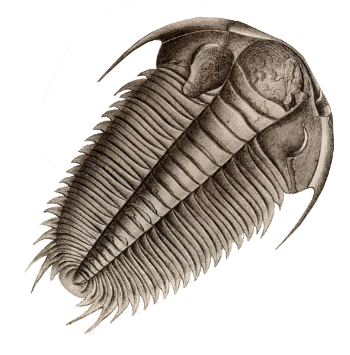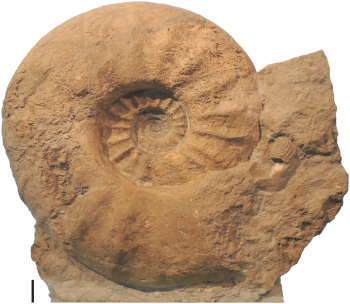The Largest Ammonite
January 10, 2022
When people think of
fossils, what come to mind are the huge
dinosaur skeletons that adorn many large
natural history museums. Such fossils are rare, but the fossils of smaller
species are more abundant. In today's world, simple observation indicates that there are many more smaller
animals, such as
field mice, than larger animals, such as
elephants. One
theory suggests that this is a consequence of an animal's
habitat requirement. Viewing the
Earth's surface as a
plane, the number of habitats (and the number of species) should be
proportional to 1/L
2, where L is the animal's
length.
The
Cambrian explosion, starting about 541
million years ago, was a time of rapid
diversification of
organisms, one type being the
marine arthropods, the
trilobites. Trilobites were among the most successful of early animals, and more than 20,000 trilobite species populated the
oceans over a period of more than a quarter billion years. Trilobite fossils are common enough that they can be bought for a few thousand
dollars.

Trilobites Illustration (Plate 3, vol. I, suppl. II) from the 1852 Système silurien du centre de la Bohême by Joachim Barrande (1799-1883).
Barrande was a French paleontologist who published this landmark study of trilobites.
The name, "trilobite," derives from the Greek words τρι- (tri-, "three") and λοβος (lobos, "lobe").
Radioactive trilobites made an appearance in the first Godzilla movie (Godzilla, 1954, Ishiro Honda, Director).[1-3]
(Portion of a Wikimedia Commons image.)
The
Cambrian Period ended 485.4 million years ago. About 65 million years later marked the start of the
Devonian Period, and also the appearance of
ammonites (Ammonoidea) in the fossil record. Ammonites are
molluscs belonging to the same
Cephalopod class as the
octopuses.
Ammonites get their name from the
Egyptian god,
Amun, whose
Latin name is Ammon. Since ammonites are
coiled like
rams'
horns,
Pliny the Elder (23-79 A.D.) called ammonite fossils
ammonis cornua ("horns of Ammon") because Ammon is usually depicted as wearing rams' horns. Most trilobite
genera became
extinct during the
Late Devonian extinction that started about 375 million years ago. Ammonites became extinct during the same
Cretaceous-Paleogene (K–Pg) extinction event (also known as the Cretaceous-Tertiary (K-T) extinction) that killed-off the dinosaurs about 66 million years ago. Ammonite fossils are much more plentiful than trilobite fossils,
selling for a tenth the price, a few hundred dollars.
Both trilobites and ammonites existed over a wide range of sizes, from as small as a few
millimeters to as large as 60
centimeters for trilobites and several
meters for ammonites. A recent
open access publication in
PLOS by a
research team from the
Ruprecht-Karls-Universität Heidelberg (Heidelberg, Germany), the
Museo del Desierto (Coahuila, Mexico), the
University of Portsmouth (Portsmouth, United Kingdom) and the
Natural History Museum (London, United Kingdom) examines the
ontogeny (the organization and development over its lifespan),
evolution, and
palaeogeographic distribution of the world’s largest ammonite,
Parapuzosia seppenradensis. This larger-than-human-sized ammonite lived during the
Lower Campanian Epoch of the
Late Cretaceous period, about 75 million years ago.

Lectotype of the ammonite, Parapuzosia seppenradensis, from Westfalia, Germany, collected in 1894 near Seppenrade.
This specimen is at the LWL-Museum for Natural History, Münster, Germany.
The scale line is 100 mm.
(Fig. 1 of ref. 4.[4] Image by Ifrim et al., 2021, PLOS ONE, licensed under a Creative Commons Attribution 4.0 International License. Also found here. Click for larger image.)
The first Parapuzosia seppenradensis ammonite fossil was discovered in 1895.[4] The specimen, discovered near
Seppenrade in
Westfalia, Germany, had a
diameter of 1.74 meters.[4] As can be deduced from the late date of its discovery in the
fossil record, fossil findings of this species were exceedingly rare, as were its systematic position and distribution.[4] The present study
catalogues 154 specimens of large (less than 1 meter in diameter) to giant (greater than 1 meter in diameter) from the
Santonian and
lower Campanian.[4] The study was enabled by many new speciemns from
England and
Mexico, and high-resolution
stratigraphy allowed for precise
correlation of the occurrences on both sides of the
Atlantic.[4]
It's conjectured that this large ammonite species evolved from
Parapuzosia leptophylla, which was discovered in 1857.[4] That species had shell diameters of about 1 meter, it flourished near
Europe in the early Santonian, and it reached the
Gulf of Mexico during the late Santonian.[4] Parapuzosia seppenradensis first appeared just before the Campanian on both sides of the Atlantic.[4] Initially, its diameter was only about 1 m, but it gradually increased in size to diameters of 1.5-1.8 meters in the middle early Campanian.[4] As shown in the figure, Parapuzosia seppenradensis had five
ontogenetic growth stages.[4] The gigantism of the species is an
outlier in the general trend of size increase for
late Cretaceous cephalopods.[4] It's possible that the increase in size of
mosasaurs, the top Cretaceous
predators, may have driven this size increase.[4]

Shell diameter and associated growth stage in the ammonite, Parapuzosia seppenradensis.
The specimens were from Mexico, Texas, Montana, England and Germany.
(Simplified version of Fig. 5 of ref. 4,[4] created using Inkscape. Base image by Ifrim et al., 2021, PLOS ONE, licensed under a Creative Commons Attribution 4.0 International License. Click for larger image.)
References:
- Godzilla (1954, Ishiro Honda, Director), on the Internet Movie Database.
- Akira Ifukube (1914-2006), Godzilla Medley, YouTube Video by Habanerotube, August 11, 2010.
- Trilobite Discovery (1954), YouTube video by Spike Genalo, May 26, 2011.
- Christina Ifrim, Wolfgang Stinnesbeck, Arturo H. González González, Nils Schorndorf, and Andrew S. Gale, "Ontogeny, evolution and palaeogeographic distribution of the world’s largest ammonite Parapuzosia (P.) seppenradensis (Landois, 1895)," PLOS, November 10, 2021, https://doi.org/10.1371/journal.pone.0258510.
Linked Keywords: Fossil; dinosaur; skeleton; natural history museum; species; animal; vole; field mouse; elephant; theory; habitat; lithosphere; Earth's surface; plane (geometry); proportionality (mathematics); proportional; length; Cambrian explosion; year; Mya; million years; genetic divergence; diversification; organism; ocean; marine; arthropod; trilobite; United States dollar; illustration; Joachim Barrande (1799-1883); France; French; paleontology; paleontologist; scientific literature; publish; Greek language; Greek word; radioactive decay; Godzilla (1954 film); first Godzilla movie; Ishiro Honda; film director; Wikimedia Commons; Cambrian Period; Devonian Period; Ammonoidea; ammonite; Mollusca; mollusc; cephalopod; class (biology); octopus; Ancient Egyptian deity; Egyptian god; Amun; Latin; coil; coiled; sheep; ram; horn (anatomy); Pliny the Elder (23-79 A.D.); genus; genera; extinction; extinct; Late Devonian; Cretaceous-Paleogene (K–Pg) extinction event; sales; selling; millimeter; centimeter; meter; open access; research; Ruprecht-Karls-Universität Heidelberg (Heidelberg, Germany); Museo del Desierto (Coahuila, Mexico); University of Portsmouth (Portsmouth, United Kingdom); Natural History Museum (London, United Kingdom); ontogeny; evolution; palaeogeographic; geography; distribution; Parapuzosia seppenradensis; Lower Campanian; epoch (geology); Late Cretaceous period; type (biology); Lectotype; Westfalia, Germany; Seppenrade; specimen; LWL-Museum for Natural History, Münster, Germany; Creative Commons Attribution 4.0 International License; diameter; fossil record; catalogue; Santonian; lower Campanian; England; Mexico; stratigraphy; correlation; Atlantic Ocean; Europe; Gulf of Mexico; ontogeny; ontogenetic growth stages; outlier; late Cretaceous; cephalopod; mosasaur; predation; predator; seashell; shell; Texas; Montana; England; Germany; Inkscape; Akira Ifukube (1914-2006).